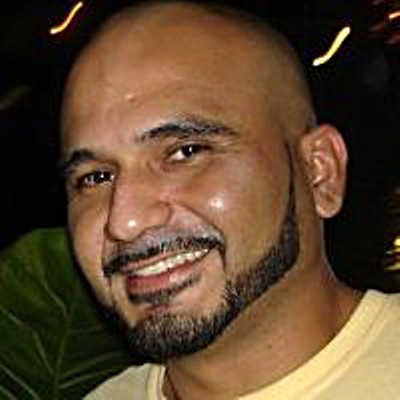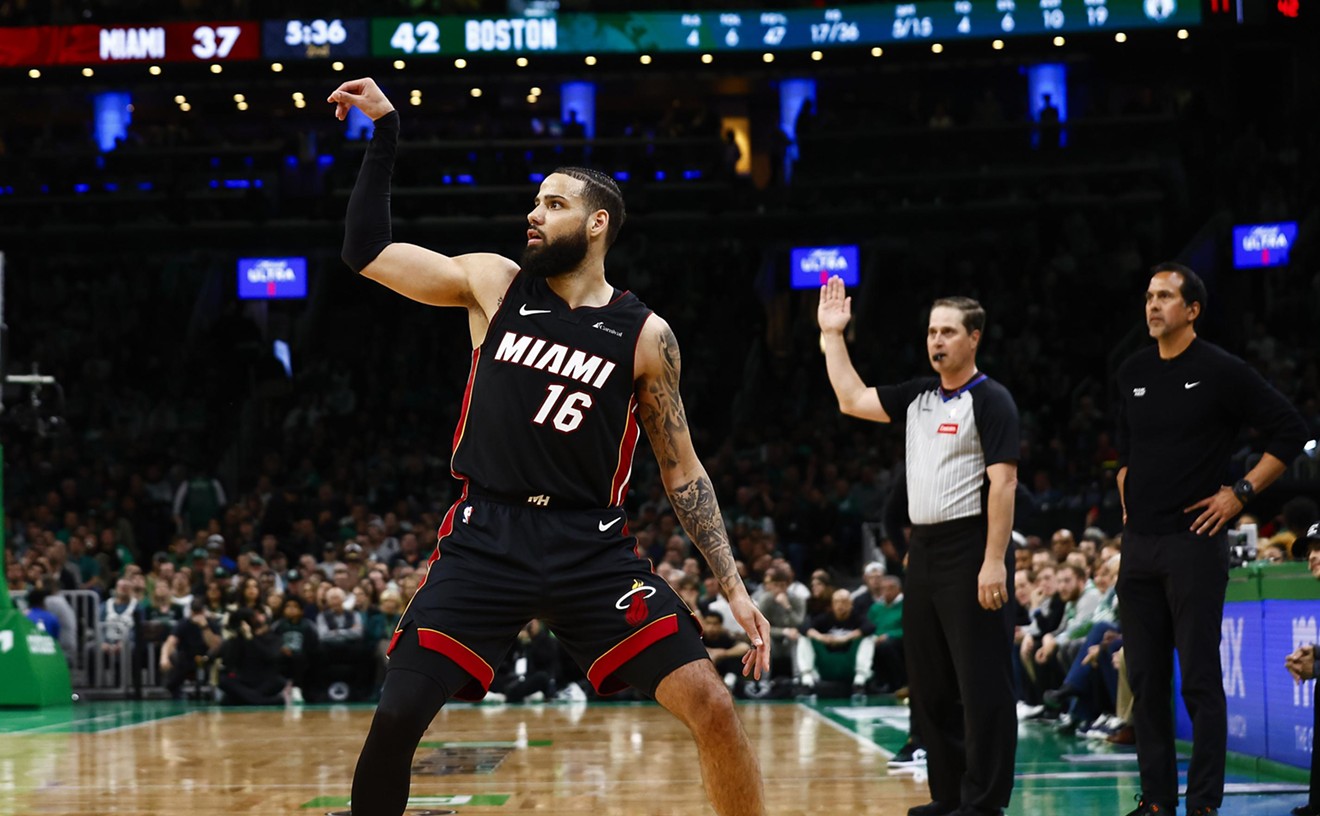Detective Suberto Hernandez, a heavyset undercover cop with a scraggly beard and long greasy hair, pulled to a stop in an unmarked car just south of Calle Ocho on a quiet Little Havana corner across from a vacant grass lot. Wearing clothes that made him look like a grungy construction worker, Hernandez approached Benigno Cardoso, an olive-skinned 55-year-old Cuban with a short buzzcut and shiny gold teeth.
"Gimme $60," Hernandez said in Spanish. Cardoso glanced around, popped the top on an aspirin bottle, and dropped six crack rocks into the narcotics officer's palm. As soon as he got back to his car, Hernandez radioed his comrades nearby: "It's a go. It's a done deal."
Minutes later, cops pulled Cardoso over and hauled him off to jail.
That's how the drug deal went down, according to a police report Hernandez later submitted. As one of the 44 Miami cops assigned to the crime-suppression unit, a tactical group focused on nabbing $50 hookers and dime-bag drug dealers, he had set up the same kind of fake deal just about every day.
Except in this case, the report is a pack of lies. Aside from the traffic stop, Hernandez fabricated the entire narrative, which he repeated in subsequent testimony against Cardoso, according to public records obtained by Miami New Times.
The drug buy was actually conducted by a neighborhood prostitute named Lourmis Martinez, whom Hernandez had threatened with jail time if she didn't serve up Cardoso. Hernandez never revealed the hooker's involvement.
The documents offer a devastating view of the underworld inhabited by a small cadre of dirty cops who planted drugs on suspects, stole dope from dealers, and falsified arrest reports. The new information could also cast doubt on the January conviction of Hernandez's boss, Sgt. Raul Iglesias. He was sent to prison on the strength of testimony by Hernandez and three other detectives who were hailed by federal prosecutors as "heroes."
Hernandez's testimony that his boss, Iglesias, had planted cocaine on a suspect helped persuade jurors to find the ex-sergeant guilty of civil rights violations, as well as conspiracy to possess and distribute cocaine. But the new records show the unethical tactics didn't begin or end with Iglesias, who is serving five and half years at Miami's Federal Detention Center.
In fact, Hernandez, who has yet to be criminally charged even though almost two years have passed since he was caught lying about Cardoso's arrest, may be just as corrupt.
Iglesias' attorney, Rick Diaz, who uncovered the truth behind Cardoso's arrest, accused Miami Police brass of ignoring Hernandez's crimes to avoid further embarrassment. "They know going after [Hernandez] could lead to Raul's conviction being overturned," Diaz says. "They don't want this case to explode."
Three attempts to reach Hernandez at his home in Southwest Miami-Dade were unsuccessful. He did not respond to a letter left in his mailbox requesting comment.
Since the 1990s, so-called crime-suppression units like the one where Hernandez and Iglesias worked have been a staple of police departments. Using battalions of plainclothes officers, CSU teams typically target street-level narcotics and prostitution activities. Miami's unit is no exception. Between 2005 and 2012, the crime-suppression team made more than 14,000 arrests for narcotics possession, prostitution, and drug trafficking, according to seven years' worth of Miami Police Department annual reports.
But such units are unusually susceptible to corruption and intimidation. Forced into the grimy realm of low-level drug slingers, motel hookers, and street pimps, they are often tempted to embrace the dark side.
Miami's vice unit, in particular, has been marred by scandal for more than a quarter-century. In December 1988, six members of the department's "Jump Out Boys" were involved in the savage beating death of Wynwood crack dealer Leonardo Mercado. Six years later, after a first trial ended in a hung jury, four of the officers were convicted of violating Mercado's civil rights. Current Chief Manuel Orosa, at the time the unit's sergeant, was -temporarily relieved of duty with pay because he failed to preserve evidence in the Mercado killing. Orosa denied wrongdoing and cooperated with federal prosecutors.
In 1995, another band of CSU cops ambushed robbers Derrick Wiltshire and Antonio Young. Both men were shot in the back as they fled four plainclothes detectives. To justify the killings, officers planted guns on the dead suspects. Two years later, a homeless man with a Sony Walkman was shot and injured by two cops from CSU. With help from another officer, they planted a gun on that suspect too.
The two incidents, among other corrupt actions, led federal prosecutors to charge 14 Miami cops with stealing suspects' guns, lying about the weapons, and then planting the firearms at crime scenes. More than half were found guilty.
A 24-year Miami Police veteran, Hernandez moved to CSU in 2003 after a nine-year stint with the robbery bureau. Iglesias had joined the unit three years earlier. They worked together until 2007, when Iglesias was transferred after his promotion to sergeant. The two cops were reunited in January 2010, when Iglesias was sent back to CSU to supervise a team that included Hernandez and other officers who would eventually testify against the sergeant.
Hernandez was twice accused of inappropriately touching female prostitutes during pat-downs. Internal affairs cleared him in both instances. Miami's Civilian Investigative Panel, a police watchdog agency, once investigated Hernandez and six other CSU members for allegedly conducting illegal searches and stealing $580 from two apartments in an Overtown complex at 25 NW Second St. on October 27, 2009.
Those claims were also mostly ruled unsubstantiated.
Iglesias, an ex-Marine combat veteran who communicated with New Times via email and handwritten letters, asserts he was assigned to Hernandez's CSU team to whip them into shape. He served two tours of duty in Iraq between 2003 and 2009, the year he was honorably discharged. "I was supposed to straighten the team out," Iglesias says. "After working with them for four months, I made it clear I was going to kick at least three detectives off the team for laziness."
Yet, unbeknown to Iglesias, internal affairs and the FBI had begun keeping tabs on his team based on an anonymous letter alleging he had planted drugs on one suspect and had provided stolen narcotics to a confidential snitch as payment for information.
In May 2010, Iglesias was relieved of duty with pay following the arrest of team member Roberto Asanza on a federal charge of cocaine possession with intent to distribute. According to the criminal complaint, Asanza stole cocaine and marijuana that had been seized from an Allapattah drug dealer and gave some of those narcotics to a snitch he had recruited. The feds also alleged Iglesias was in Asanza's truck when his subordinate provided the stolen drugs to the informant.
Iglesias was criminally charged in 2012, and his trial began in January the next year.
Hernandez and Det. Luis Valdes testified that on January 27, 2010, Iglesias' first day on the job, the sergeant asked them if they had any "thrown-down dope" to plant on a suspect. When they said no, the two cops testified, Iglesias called another officer to the scene who allegedly handed the sergeant a baggie with cocaine residue. Asanza, who pleaded guilty to misdemeanor charges, also testified against Iglesias.
On the stand, Hernandez admitted he and other members collaborated on the anonymous letter that initiated the probe against Iglesias, who was found guilty on nine counts of conspiring to possess cocaine, violating suspects' civil rights, obstructing justice, making false statements, and being criminally in contempt. Iglesias, now 42, is serving five and a half years.
"I truly believe they wrote the anonymous letter to get me thrown off the unit but did not expect an investigation," Iglesias says. "These guys have no problem lying."
Hernandez's arrest of Cardoso on May 22, 2012, is the clearest evidence of that dishonesty, Iglesias maintains. Following his conviction, Iglesias' lawyer, Diaz, began digging into Hernandez's arrest of Cardoso. He obtained recordings and transcripts of the crime-suppression team's radio transmissions on May 22, 2012. The transcripts reveal a much different version of events.
Martinez, the prostitute, was detained by Hernandez, who ordered her to call the dealer, Cardoso, who agreed to meet her at SW Ninth Street and 23rd Avenue.
According to the transcripts, Hernandez informed the other team members that he gave Martinez three marked $20 bills and that she would make the buy. After she returned to his car with the rocks, Hernandez told his squad mates to arrest Cardoso.
On March 18, 2013, Martinez admitted her role in Cardoso's setup. "If I give him information on somebody, he'll let me walk," Martinez affirmed, adding Hernandez's claim that he personally purchased drugs from Cardoso was "not true."
That information was sent to state prosecutors, who decided not to challenge a motion to vacate the Little Havana dealer's conviction and sentence. On July 23, 2013, criminal court Judge Stacy Glick ordered Cardoso's release.
Chief Orosa, who disbanded the 44-member CSU last April, declined to comment. Hernandez's status with the department is also unclear.
"I gave them a strong case with enough proof to win a conviction against Hernandez without any reasonable doubt," Diaz says. "It's unsettling that more than a year and a half later, the Miami Police Department hasn't acted on it."
Follow Miami New Times on Facebook and Twitter @MiamiNewTimes.











